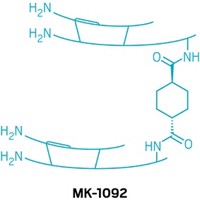Advertisement
Grab your lab coat. Let's get started
Welcome!
Welcome!
Create an account below to get 6 C&EN articles per month, receive newsletters and more - all free.
It seems this is your first time logging in online. Please enter the following information to continue.
As an ACS member you automatically get access to this site. All we need is few more details to create your reading experience.
Not you? Sign in with a different account.
Not you? Sign in with a different account.
ERROR 1
ERROR 1
ERROR 2
ERROR 2
ERROR 2
ERROR 2
ERROR 2
Password and Confirm password must match.
If you have an ACS member number, please enter it here so we can link this account to your membership. (optional)
ERROR 2
ACS values your privacy. By submitting your information, you are gaining access to C&EN and subscribing to our weekly newsletter. We use the information you provide to make your reading experience better, and we will never sell your data to third party members.
Biological Chemistry
α/β-Peptides Could Offer Low-Cost Alternative To Antibody Drugs
Drug Design: Researchers mix natural and nonnatural amino acids to make peptides that target large proteins
by Stu Borman
April 6, 2015
| A version of this story appeared in
Volume 93, Issue 14

A peptide scaffold made partly of nonnatural β-amino acids could serve as a versatile source of potential drugs that bind large proteins such as the anticancer target VEGF, researchers report. The nonnatural peptides offer a possibly advantageous alternative to antibody-based agents that target large proteins because the peptides are easier to make and may last longer in the body.
To modulate the activity of proteins such as VEGF, drugmakers must block their interactions with other proteins. These interactions occur over large surface areas, making them difficult to interrupt with conventional small-molecule drugs. Antibody-based agents are large enough to be effective but are expensive, hard to produce, and can be susceptible to enzymatic breakdown in the body.
Some researchers have tried to bridge the gap between small molecules and antibodies by developing midsized scaffolds that can interact with large proteins. In the mid-1990s, Per-Åke Nygren of the Royal Institute of Technology, in Stockholm, and coworkers showed that the Z-domain, a three-helix fragment of a bacterial protein, fulfills that role. A group led by James A. Wells, now at the University of California, San Francisco, then demonstrated that a trimmed-down, two-helix version of the scaffold retained the parent structure’s binding versatility.
Now, Samuel H. Gellman, William L. Murphy, Katrina T. Forest, and coworkers at the University of Wisconsin, Madison, have eliminated one of the three helices of a Z-domain peptide and replaced some of the native α-amino acids in the two remaining helices with nonnatural β-amino acids (Proc. Natl. Acad. Sci. USA 2015, DOI: 10.1073/pnas.1420380112).
Peptides composed of both α- and β-amino acids have been made before, but researchers have not tested them as stand-ins for three-dimensional folded structures such as Z-domain peptides. These mixed α/β-peptides could last longer in people than antibodies because they resist enzymatic breakdown. And unlike antibodies, they can be chemically synthesized, making them potentially less expensive.
Despite its smaller size, a two-helix α/β-peptide had affinity for VEGF comparable with that of a VEGF-binding three-helix Z-domain. It inhibited the growth of cells lining blood vessels, which VEGF promotes in cancerous tissue. And the α/β scaffold is versatile: The researchers created two modified versions that also selectively bind the large proteins TNF-α and IgG.
Chemical biologist Andrew J. Wilson of the University of Leeds, in England, comments that integrating α/β-modified peptides into a rational approach for protein-targeted drug design “represents a significant technical breakthrough.”
Wells adds that the work is the first demonstration that 3-D folded α/β-peptides can retain tertiary structures similar to those adopted by the corresponding Z-domain α-peptides.
The Wisconsin Alumni Research Foundation has filed for a patent on protein-targeting α/β-peptides, and Longevity Biotech, in Philadelphia, cofounded by Gellman, is pursuing commercialization efforts.




Join the conversation
Contact the reporter
Submit a Letter to the Editor for publication
Engage with us on Twitter